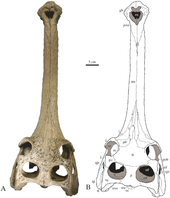Gavialis
| Gavialis Temporal range: Early Miocene - recent, 20–0 Ma | |
|---|---|
 | |
| The gharial (Gavialis gangeticus), the only living species of Gavialis | |
| Scientific classification | |
| Kingdom: | Animalia |
| Phylum: | Chordata |
| Class: | Reptilia |
| Superorder: | Crocodylomorpha |
| Order: | Crocodilia |
| Family: | Gavialidae |
| Subfamily: | Gavialinae |
| Genus: | Gavialis Oppel, 1811 |
Gavialis is a genus of crocodylians that includes the living gharial Gavialis gangeticus and several extinct species, including Gavialis bengawanicus, Gavialis breviceps, Gavialis browni, Gavialis curvirostris, Gavialis hysudricus, Gavialis leptodus, Gavialis lewisi, and Gavialis pachyrhynchus. Most species, including G. gangeticus, come from the Indian Subcontinent,[1] while G. bengawanicus is known from Java. Gavialis likely first appeared in the Indian Subcontinent in the early Miocene around 20 million years ago and dispersed into the Malay Archipelago through a path called the Siva–Malayan route in the Quaternary. Remains attributed to Gavialis have also been found on Sulawesi and Woodlark Island east of the Wallace Line, suggesting a prehistoric lineage of Gavialis was able to traverse marine environments and reach places possibly as far as western Oceania.[2]

References
- ↑ Lull, R. S. (1944). "Fossil gavials from north India". American Journal of Science. 242 (8): 417–430. doi:10.2475/ajs.242.8.417.
- ↑ Delfino, M.; De Vos, J. (2010). "A revision of the Dubois crocodylians, Gavialis bengawanicus and Crocodylus ossifragus, from the Pleistocene Homo erectus beds of Java". Journal of Vertebrate Paleontology. 30 (2): 427. doi:10.1080/02724631003617910.